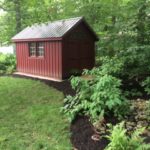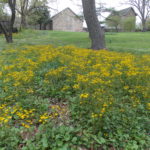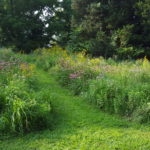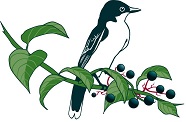Gasoline-powered landscape equipment, including mowers, trimmers, blowers, and chainsaws, accounts for 16 percent of hydrocarbon emissions and 21 percent of carbon monoxide emissions from mobile sources nationwide.” -US EPA, 2003
Mowing the lawn is wasteful. If you hire a service, you’re spending dollars and if you mow your own lawn, you’re spending your time (arguably more valuable!). But regardless of who does the mowing, the process is consuming fossil fuels and releasing air pollution.
So while having lawn in select areas is desirable for playing or walking, let’s consider some of these alternatives to save dollars, time, and the environment.
Gardens
 Gardens are one of our favorite options to reduce lawn because of the color, texture, and habitat value they often provide. A diverse selection of plants is not just interesting, it’s also insurance against pests & disease. And if you don’t think you have a green thumb, there’s also help with that. Some bullet-proof plants can be neglected and they’ll still come back year after year, just ask your favorite landscaper or garden center for suggestions.
Gardens are one of our favorite options to reduce lawn because of the color, texture, and habitat value they often provide. A diverse selection of plants is not just interesting, it’s also insurance against pests & disease. And if you don’t think you have a green thumb, there’s also help with that. Some bullet-proof plants can be neglected and they’ll still come back year after year, just ask your favorite landscaper or garden center for suggestions.
Evaluating planting a garden:
| Benefits | Drawbacks |
| Reduces carbon emissions produced from mowing | Requires regular weeding; varies depending on layout |
| Diverse plants for interest & insurance | Requires regular irrigation through the first growing season; some supplemental during droughts and heat waves in second year |
| Lots of options for shape, color, texture, & fragrance | Can be expensive to install depending on source & size of initial plants |
| Supports wildlife & pollinators | |
| Increases property value | |
| Creates a more inviting or restful space for people and pets | |
| Options available for shady sites |
Groundcover plants:
 Planting English Ivy and Pachysandra have been a tried and true practice for reducing lawn. Unfortunately they form monocultures, so if a disease moves in, it may kill the whole stand of groundcover. We have seen this over the last two years with a fungus that is killing English Ivy. Still, if reducing mowing is your only goal, a monoculture groundcover might be the solution; consider a native groundcover such as Golden Groundsel (Packera aurea).
Planting English Ivy and Pachysandra have been a tried and true practice for reducing lawn. Unfortunately they form monocultures, so if a disease moves in, it may kill the whole stand of groundcover. We have seen this over the last two years with a fungus that is killing English Ivy. Still, if reducing mowing is your only goal, a monoculture groundcover might be the solution; consider a native groundcover such as Golden Groundsel (Packera aurea).
Evaluating installing a single species of groundcover:
| Benefits | Drawbacks |
| Reduces carbon emissions produced from mowing | Monoculture of a species; lacks diversity |
| Can provide similar low evergreen attributes as lawn | One disease or pest may wipe out a large area |
| Stabilizes the soil | Can be aggressive and spread outside of intended space |
| Once established, usually dense enough to prevent many weeds | Provides little habitat value |
| Often considered traditional and “acceptable” to surrounding community | Often considered traditional and “acceptable” to surrounding community |
Released turf grass
 This option is the easiest and most affordable- stop mowing or reduce mowing to only 2-3 times per year. This look may not work for your front yard, depending where you live, but it can actually be quite attractive. The key to released turf grass is to provide “cues to care”. These are little indicators around the property that show it is being cared for (and your house isn’t under foreclosure!). Strategically placed fence sections; a mow strip; a curvy border to the released area, all of these cues help let people know this is an intentional release.
This option is the easiest and most affordable- stop mowing or reduce mowing to only 2-3 times per year. This look may not work for your front yard, depending where you live, but it can actually be quite attractive. The key to released turf grass is to provide “cues to care”. These are little indicators around the property that show it is being cared for (and your house isn’t under foreclosure!). Strategically placed fence sections; a mow strip; a curvy border to the released area, all of these cues help let people know this is an intentional release.
Evaluating release of turf grass (most all are non-native):
| Benefits | Drawbacks |
| Reduces carbon emissions produced from mowing | Provides little habitat value |
| Inexpensive to do | Requires cues to care, depending on location of property |
| Low, upright habit | May support ticks* |
| Roots grow deeper- better for stormwater and soil | Can become weedy over time |
| When flowering plants or weeds move in, looks more like a meadow |
No-Mow Mix
 Similar to released turf grass, a no-mow mix is a low stand turf grass, but in this instance, the grasses are specific fine fescues. Many lawns contain fescues, but also ryes, bluegrasses, and other types of tall fescues, resulting in a more upright habit when released. When fine fescues are not mowed, they flop over and create a very soft, shiny effect.
Similar to released turf grass, a no-mow mix is a low stand turf grass, but in this instance, the grasses are specific fine fescues. Many lawns contain fescues, but also ryes, bluegrasses, and other types of tall fescues, resulting in a more upright habit when released. When fine fescues are not mowed, they flop over and create a very soft, shiny effect.
Evaluating installing a no-mow mix:
| Benefits | Drawbacks |
| Reduces carbon emissions produced from mowing | Usually needs to be installed in place of existing grass, so it is more costly than released turf |
| Low, floppy habit | May support ticks* |
| Soft, shiny texture of fine fescues | Does not tolerate as much heavy foot traffic as lawn |
| Tolerates shade better than turf or meadow grasses | Weeds are noticeable in fine fescues |
| Mow 1-3 times per year |
Native Warm Season Grass Meadow
 A native meadow consists of at least warm-season grasses and may have wildflowers sown in as well. It is a complex habitat full of diversity and interest and is taller than un-mowed turf grasses (reaching 3-5 feet tall). A meadow may not be right for every property, but they look especially appropriate on farms or properties near farms where the meadow adds to the overall feeling of that landscape- think Chester County or Willistown. Meadows often benefit from “cues to care”, especially in the establishment years. Meadows win double points for beauty in our opinions!
A native meadow consists of at least warm-season grasses and may have wildflowers sown in as well. It is a complex habitat full of diversity and interest and is taller than un-mowed turf grasses (reaching 3-5 feet tall). A meadow may not be right for every property, but they look especially appropriate on farms or properties near farms where the meadow adds to the overall feeling of that landscape- think Chester County or Willistown. Meadows often benefit from “cues to care”, especially in the establishment years. Meadows win double points for beauty in our opinions!
Evaluating installation of a native, warm season grass meadow:
| Benefit | Drawback |
| Reduces carbon emissions produced from mowing | Can be expensive to install |
| Various colors and textures through the seasons | Takes 3 years to establish from seed |
| Only mow once per year after establishment | Must scout regularly for invasive species |
| Provides habitat for wildlife and pollinators, including ground-nesting birds | May support ticks* |
| Can mow paths through the meadow for a unique type of private landscape |
On most properties, turf grass is necessary. It is great for playing or walking, but if it’s not used for foot traffic, there’s likely an alternative. Consider the benefits you prefer and the drawbacks you can tolerate and hopefully you can begin the process of reducing lawn on your property.
*More hospitable landscapes support more types of wildlife; unfortunately, these also may support ticks. The good news is that diversity in plantings will strengthen the threads of the food web, and many insects can be managed naturally this way.


